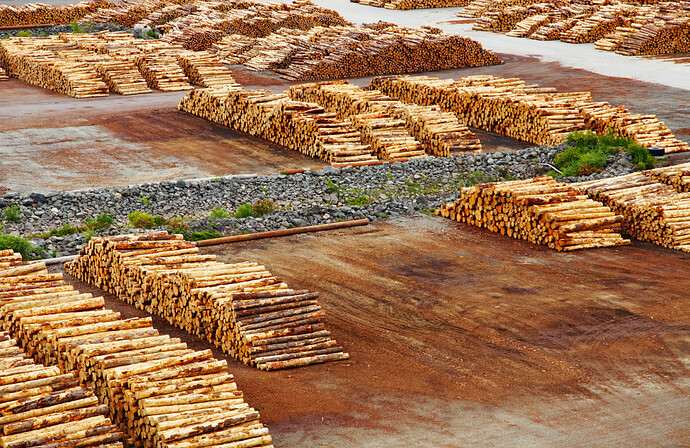New Zealand’s export log prices have experienced a significant decline, reaching their lowest point since July last year, according to the latest report from PF Olsen, a leading forestry services provider in New Zealand. The report highlights a decrease of an average of $22 per JASm3 at Wharf Gate (AWG) prices for export logs in May after decline $20-25 per JASm3 in April.
The drop in prices can be attributed to several factors. The CFR log sale price in China for New Zealand pine A grade has plummeted to a range of 108-115 USD per JAS m3. While softwood inventory and log demand in China have remained stable, the anticipated increase in construction activity has not materialized. Furthermore, as China enters its hotter months of June to August, a period traditionally associated with reduced construction activity, the likelihood of a significant increase in the near future is diminishing. According to Lesprom Analytics, the average price for logs imported to China gained 4% In April.
The May PF Olsen Log Price Index reflects this downward trend, declining by $11 to $113. This marks the lowest level for the index since July last year. It is currently $9 below the two-year average and $10 below the five-year average, indicating a challenging market for export logs.
In the domestic log market, the demand has decreased, leading many mills to reduce their log orders. Prices have remained stable for Quarter 2, but the local structural market is facing an oversupply issue. During the Covid lockdowns, DIY projects such as building decks and home improvements saw a surge, resulting in reduced discretionary spending by households. Additionally, new build starts have slowed, and logistical warehousing builds, although ongoing, have reduced timber input compared to dwellings.
China, one of New Zealand’s major export destinations, has witnessed a drop in softwood log inventory, reaching approximately 3 million m3, with radiata accounting for about 2.75 million m3. However, port off-take has remained steady at around 70,000 m3 per day. Despite the usual decline of construction activity during the hotter months, industry commentators expect a less significant drop this year due to the already lower but consistent construction levels. Moreover, low inventory levels throughout the supply chain are likely to prevent a sharp decline in daily port off-take.
In addition to the challenges in the Chinese market, increased supply from domestic harvesting of Masson pine in southern and central China and Poplar in Northern China has further impacted the situation. These domestic logs sell at an average price of 800 RMB per m3 ($113 USD), making them more attractive to buyers. Although the 2020 ban on Australian logs and timber imports has been lifted, log buyers in China do not anticipate a substantial increase in log volume from Australian suppliers, especially considering the current pricing levels.
Cashflow constraints remain a significant issue for log buyers and construction companies in China. The construction sector in the country experiences the longest average payment delay, averaging 96 days. The recent contraction in factory activity, as indicated by the China Caixin manufacturing PMI dropping to 49.5 in April, adds to the overall market uncertainty, with fears of a global slowdown and the property market not meeting previous activity forecasts.
Meanwhile, in India, prices for green sawn timber have remained stable in Gandhidham over the past three weeks. Green sawn timber from South American pine is priced at 501 INR per CFT, while Australian radiata green pine sells for 561 INR per CFT. European kiln-dried sawn timber is priced at 621 INR per CFT. However, demand for all construction materials in India is currently low.
